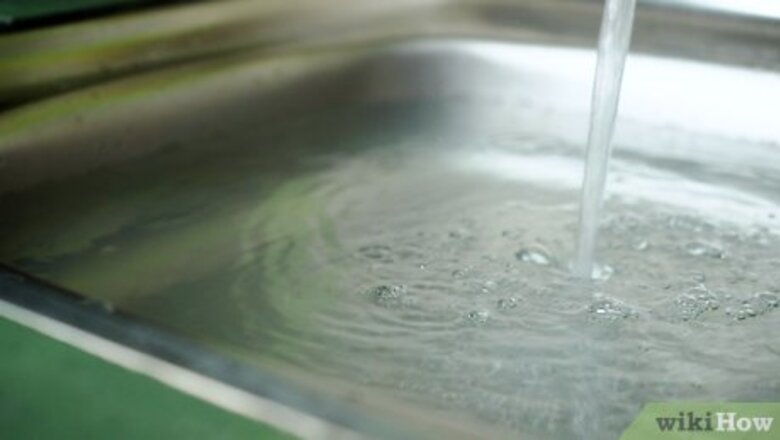
views
Hand-Washing Clothes with Shampoo
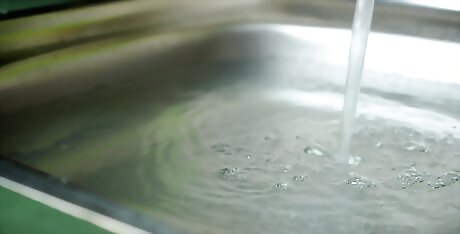
Fill a sink with warm or cold water depending on the fabric. Check the care instructions on each article of clothing you plan to wash. If there's no tag, use cold water just to be safe. Use warm water for cotton, linen, and synthetic fabrics. If the clothes are heavily soiled, use hot water. If you're washing any white articles of clothing with any red or dark ones, use cold water. For delicate fabrics like silk and lace, use cold water. While you can hand-wash “dry clean only” items, it’s best to take them to a professional cleaner.
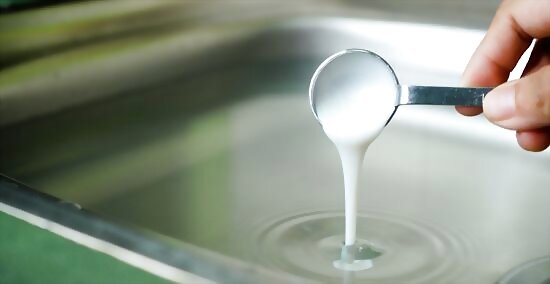
Add 1 teaspoon (4.9 mL) of gentle shampoo to make the water soapy. Squirt a mild shampoo that doesn't contain tints or dyes into the water and stir it around until the water is sudsy. Baby shampoo is a great choice because it will work just as well as laundry detergent and leave behind a fresh, subtle scent. If you're not sure if your shampoo has a tint, types that specify “correct grays” or “boost color” are almost always tinted. Don't use 2-in-1 shampoo and conditioner blends because the conditioner contains oils that will stick to clothing fibers. If you’re using more than 128 fluid ounces (3,800 mL), you may need to add another 1 teaspoon (4.9 mL) of shampoo.
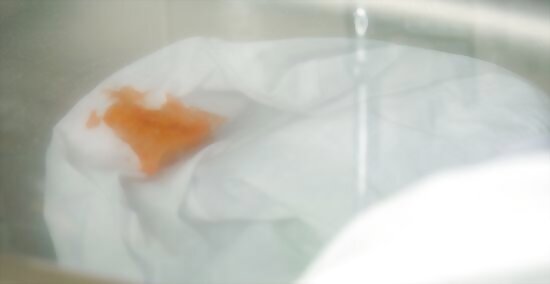
Place the clothing into the water and let it soak for 2 to 5 minutes. Place 1 or 2 pieces of clothing into the water and push down any air pockets so the entire garment is submerged. Let it soak for 5 minutes so the shampoo and water can penetrate the fibers. For heavily soiled clothing, let it soak for 10 minutes. If you’re washing small items like underwear, you can wash 4 or 5 at a time. If you’re washing a t-shirt or pair of pants, only wash 1 at a time.
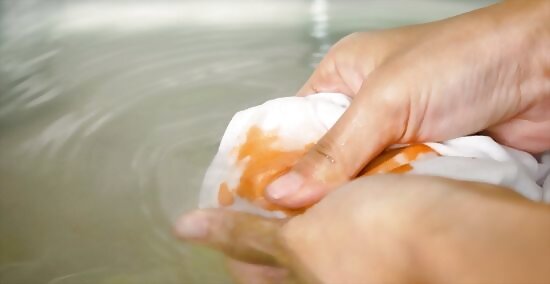
Massage the soapy water into the fibers at the most soiled parts. Hold the garment at the most soiled areas and use your fingers to work the soapy water through the clothing fibers. Be gentle with thin fabrics (like Pima cotton) and avoid pulling or overstretching the fibers. For instance, if you're washing a shirt, focus on the underarm areas.
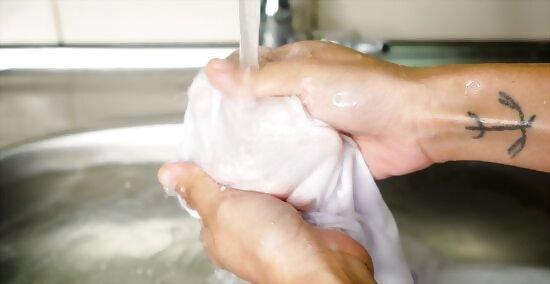
Remove the clothing and rinse it under clean water. Lift the garment out of the water and turn on the faucet—if you washed it in warm water, use warm water to rinse it (and vice versa). Make sure to rinse the entire garment, especially the parts where you focused on cleaning. You can use the same sink for rinsing, a bathtub faucet, or a different sink if you have one available.
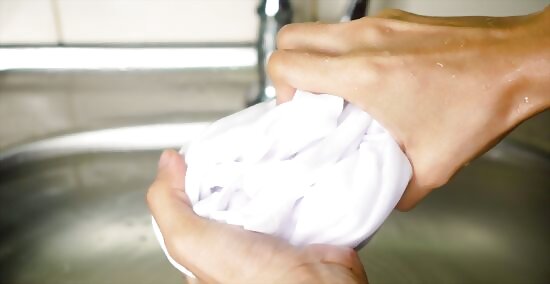
Squeeze out the water very gently. Hold the wet garment over the sink and give it a light squeeze to remove excess water. Avoid wringing the garment very tight because doing so can stretch the fibers. You can also lay a clean, dry towel onto a countertop and place the wet garment on top of it. Then roll the towel and garment together (like a sushi roll), squeezing out the moisture as you roll.
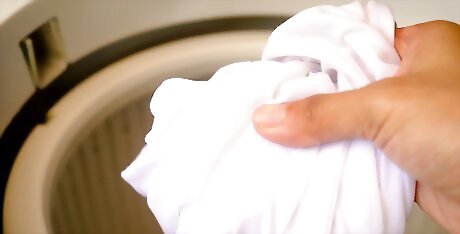
Air-dry the piece of clothing or use a tumble dryer. Check the care instructions on the label to see if you should hang dry it, lay it flat, or tumble dry it in the dryer on low or high heat. If you’re not sure, lay the garment flat to dry because it will retain its shape better that way. To flat-dry a garment lay a dry towel over a countertop and place the garment on top, reshaping it and ironing out as many wrinkles as you can with your hands. Check to see if the front is dry after 2 hours and if so, flip it over so the back is exposed to air. To hang dry, lay the garment flat and go over it with your hands to remove as many wrinkles as you can. Then, hang it up to dry in a place that gets decent airflow. If the garment can be put in the dryer but you don’t have access to one, use a hairdryer set to low heat and dry it by hand.
Spot-Treating Stains
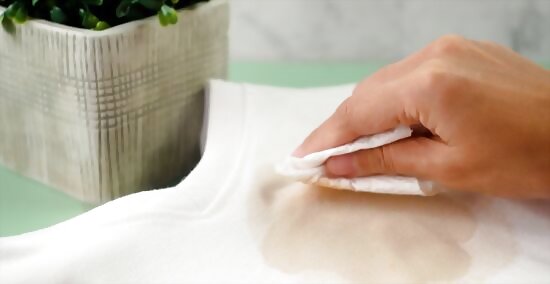
Remove as much of the staining material as you can. If it’s a liquid stain from coffee, tea, wine, beer, or soy sauce, rinse the affected area under cool running water as soon as possible. If the stain is from something solid (or semi-solid) like dirt, ice cream, or peanut butter, use a paper towel to grab and lift off as much of it as you can. Don’t try to brush or wipe it away because it will spread the stain. For instance, if you’re dealing with a ketchup stain, use a paper towel or napkin to grab and lift away as much of the ketchup as you can without spreading it. It may help to use a dull butter knife or spoon to lift away solid materials.
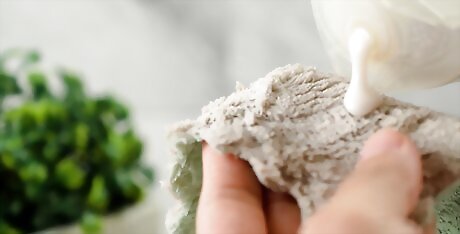
Add a drop of shampoo to a damp rag. Wet a small section of a rag with water and squeeze a pea-sized amount of shampoo onto the damp rag. Then, make a small fold in the damp spot so you can rub it together. Use cold or warm/hot water depending on the type of stain. Use warm water to remove stains from sweat, vomit, dirt, grease, oil, dye (including markers), and tomato-based products. Cold water is most effective on stains from blood, coffee, tea, soda, wine, beer, soy sauce, and jelly.
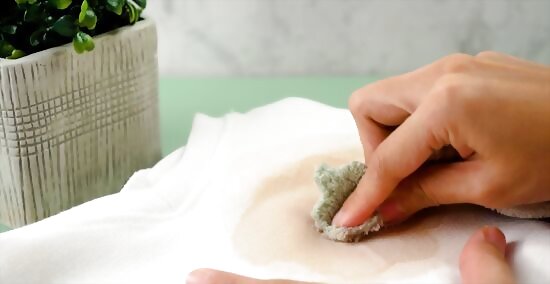
Blot the stain with the rag, reapplying water and shampoo as needed. For deep-set stains, it may help to blot it on one side, turn the clothing inside out, and blot it again from the other side. Rewet the rag and add more shampoo if you need to. You should start to see the stain lift as you blot it away. If the stain is stubborn, use small, gentle movements to rub the stain—be careful not to spread it over a larger area of the clothing. Don’t rub the stained area against itself because this can cause the stain to spread and go deeper into the clothing fibers.
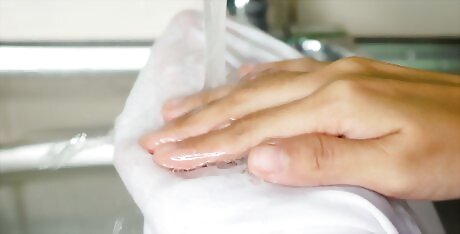
Rinse the affected area and wash the garment as usual. Hold the affected area under the faucet and rinse away the shampoo and water using the same temperature of water you used to blot it. If the stain has completely come out, wash the garment as you normally would in the washing machine using regular detergent. If you can still see it, blot it again with shampoo and water. If you can’t wash the garment with detergent in a washing machine, soak it in the sink with shampoo and water. If you don’t have detergent, use the sink method—do not put shampoo in the washing machine because doing so can leave you with a bubbly mess on the floor!

Reshape the garment and then hang it or lay it flat to dry. Refer to the care instructions on the tag to see which method is best for your particular item. If you still see remnants of the stain, try spot treating and rinsing it again. Never put a stained garment into the dryer—it will set the stain and make it harder to remove later on.


















Comments
0 comment